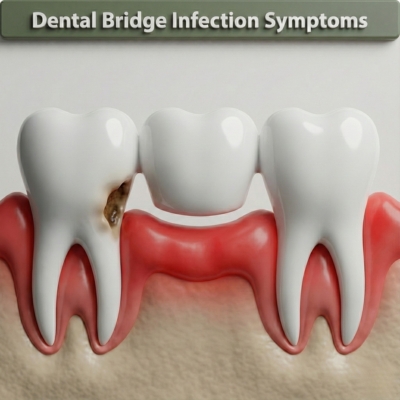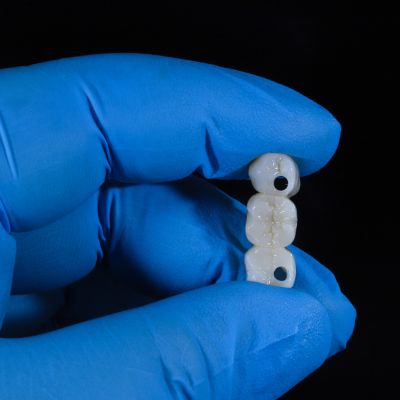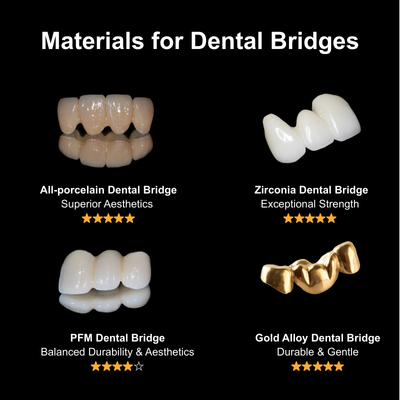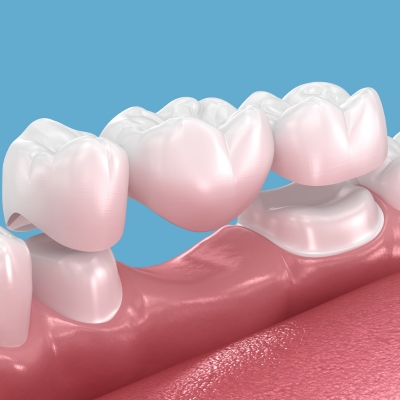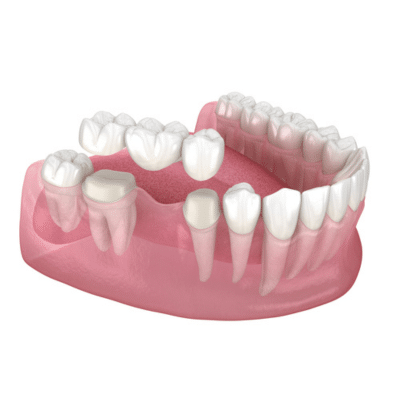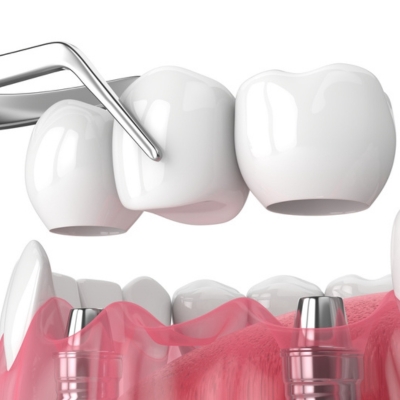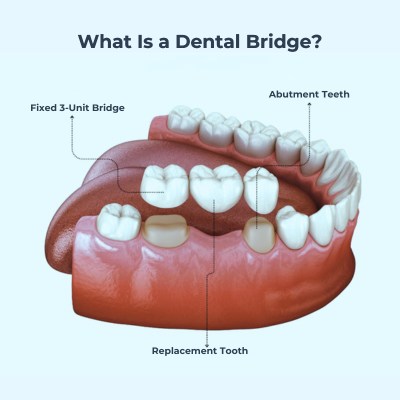News + Articles
What Is a Dental Bridge?
A dental bridge is a custom-made, fixed dental restoration used to replace one or more missing teeth. It restores your bite by permanently joining an artificial tooth, known as a pontic, to adjacent natural teeth or dental implants for support.
At Restoration Dental OC, we specialize in creating custom bridges that seamlessly restore your smile’s function and provide a natural, aesthetic appearance.
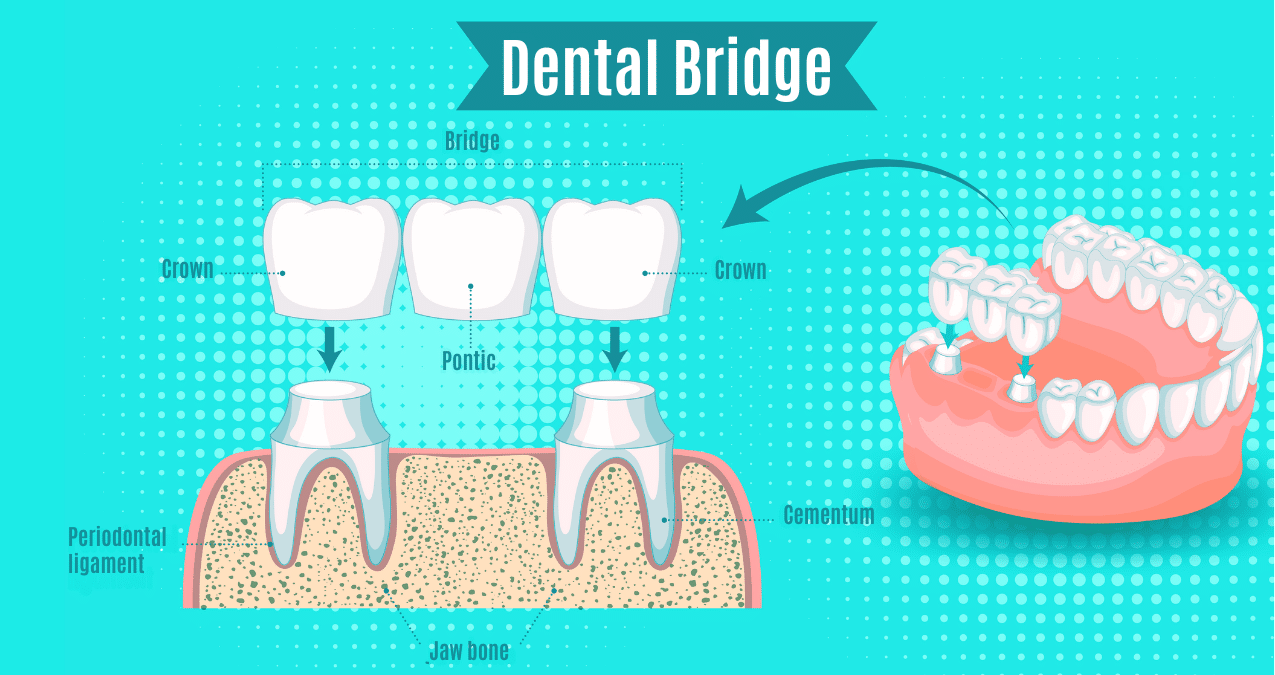
This guide explains why a bridge is necessary, who makes an ideal candidate, the four main types available, and details our 5-step gentle procedure. We will also cover essential information on longevity, cost, and alternatives to help you make a fully informed decision.
Why Would Someone Need a Dental Bridge?
A dental bridge is necessary when you are missing one or more teeth and want to restore the full function and appearance of your smile. Gaps left by tooth loss can cause significant issues, including the drifting of neighboring teeth, bite imbalances, and even jaw discomfort.
Research shows that up to 25% of jawbone density can be lost within 12 months if a missing tooth isn’t properly restored.
A dental bridge actively solves these issues by:
- Maintaining normal chewing and speaking function.
- Preventing nearby teeth from shifting out of alignment.
- Helping maintain facial shape by filling the gap.
- Restoring confidence in your smile.
Whether the gap is from a front tooth or a molar, a bridge offers both functional and preventive benefits, helping you maintain long-term oral health.
Who Is an Ideal Candidate for a Dental Bridge?
While a professional consultation is essential for a definitive diagnosis, a dental bridge is considered an excellent solution for patients who meet the following criteria:
You Have Strong Adjacent Teeth: The teeth that will anchor the bridge (abutment teeth) must be stable and have sufficient bone support to handle the additional pressure.
Your Gums Are Healthy: You must be completely free of active periodontal (gum) disease to ensure the anchor teeth remain secure for years to come.
You Practice Good Oral Hygiene: You are committed to a daily routine of brushing and flossing, especially cleaning under the bridge to prevent decay and gum issues.
Conversely, a bridge may not be the best option if the potential anchor teeth are weak or structurally damaged, or if the gap from the missing teeth is too long.
The 4 Main Types of Dental Bridges
There are four primary types of dental bridges, and our dental team will help determine the best one for your specific needs. Each type uses a different method of support and is designed to address different clinical situations.
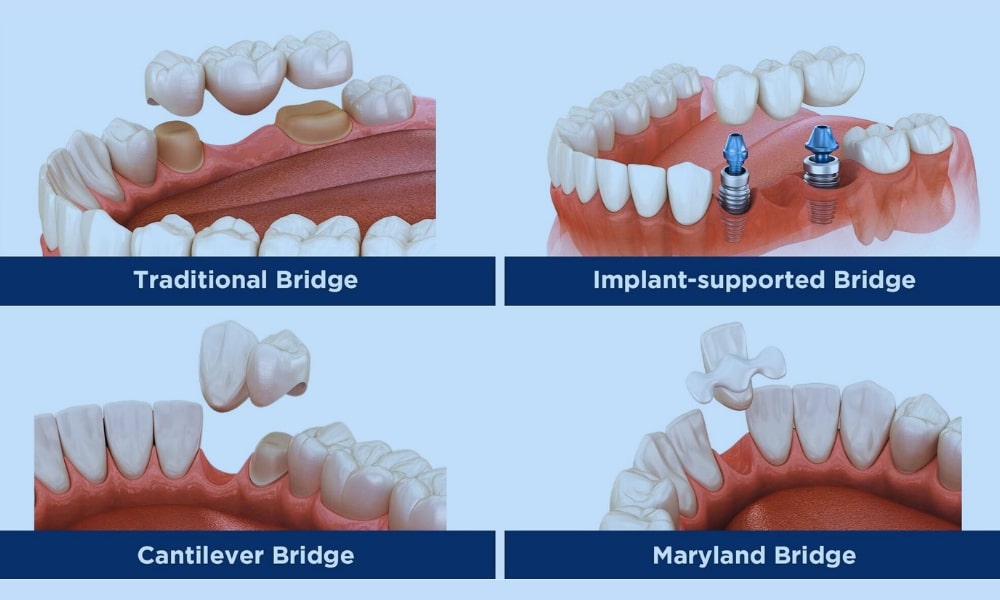
The following table compares the advantages and disadvantages of four different types of dental bridges.
Type | Teeth Replaced | Support Method | Best For | Invasiveness |
Traditional | 1+ teeth | Crowns on both abutment teeth | Strong adjacent teeth | Moderate |
Cantilever | 1 tooth | Crown on one abutment tooth | Front teeth (low bite force) | Moderate |
Maryland | 1 tooth | Metal/porcelain wings bonded to the back of adjacent teeth | Front teeth (temporary or conservative fix) | Low |
Implant-Supported | 2+ teeth | Anchored by dental implants | Multiple missing teeth, strong bone | High |
Unsure which option fits your smile and budget? Schedule a gentle, no-pressure consultation to get a personalized recommendation from our expert team.
Traditional Bridge
A traditional dental bridge is the most common type and uses dental crowns placed on the natural teeth on both sides of the gap.
These crowned teeth, known as abutments, act as strong anchors that hold the false tooth securely in place. This option works best when the adjacent teeth are strong enough to support the restoration.
Cantilever Bridge
A cantilever bridge is used when there is only one healthy adjacent tooth next to the gap. It uses a single abutment tooth to support the pontic, making it a viable option for areas with lower bite pressure, such as the front teeth.
Maryland Bridge
A Maryland bridge, also known as a resin-bonded bridge, is a more conservative option that does not require placing crowns on adjacent teeth.
Instead, it uses a metal or porcelain framework with “wings” that are bonded to the back of the neighboring teeth.
Because it preserves more of the natural tooth structure, it’s often used for replacing front teeth.
Implant-Supported Bridge
An implant-supported bridge is anchored by dental implants instead of natural teeth. This type offers superior support, helps preserve the underlying jawbone structure, and is the ideal solution if you are missing multiple teeth in a row.
Because they integrate directly with the jaw, this method shares many long-term stability benefits with standalone dental implants, which we will compare next.
The 5-Step Gentle Dental Bridge Procedure
At Restoration Dental OC, the entire dental bridge process is designed for your comfort and is typically completed in just two main visits. We use a gentle, precise approach to ensure a strong, beautiful, and natural-looking result.
Step 1: Comprehensive Consultation and Planning
First, we perform a comprehensive examination, including digital X-rays, to accurately assess your oral health.
We then discuss your goals to create a personalized treatment plan and confirm that a dental bridge is the best solution for your smile.
Step 2: Gentle Preparation of Anchor Teeth
To ensure a completely pain-free experience, we ensure the area is profoundly numb using advanced techniques for a completely sensation-free experience before gently reshaping the adjacent teeth.
Step 3: Taking a Precise Blueprint
We take highly accurate digital impressions of the prepared teeth, which serve as a blueprint for our dental laboratory. Expert technicians then craft a custom bridge designed to perfectly match the color and shape of your natural teeth.
Step 4: Placing a Comfortable Temporary Bridge
While your permanent restoration is being made, we place a custom-fitted temporary bridge. This protects the underlying teeth and allows you to eat, speak, and smile with complete confidence.
Step 5: Bonding Your Permanent Bridge
On your final visit, we take the time to meticulously check the fit, bite, and aesthetics, making minor adjustments until you are perfectly comfortable and satisfied.
How Long Do Dental Bridges Last?
A properly maintained dental bridge has a lifespan of 5 to 15 years, with many lasting even longer with excellent oral care.
On average, traditional bridges last 7–10 years, while implant-supported bridges can exceed 15 years with proper maintenance.
Longevity depends on factors like material quality, location in the mouth, and your daily oral hygiene habits.
What Are the Pros and Cons of Dental Bridges?
Dental bridges offer a practical way to replace missing teeth, but like any treatment, they come with both advantages and disadvantages.
Advantages
Quick and Convenient: Unlike dental implants, which can take several months to complete, your dentist can finish the entire bridge procedure in just two to three visits over a few weeks.
Natural Appearance: Your dentist designs the bridge to blend seamlessly with your natural teeth, helping you smile confidently and speak clearly.
Non-Surgical Option: Bridges do not require surgery, making them a great choice if you prefer a less invasive solution to replace missing teeth.
Disadvantages
Affects Adjacent Teeth: To support the bridge, your dentist needs to file down the healthy teeth next to the gap to place crowns, which permanently alters their structure.
Limited Longevity: While a bridge can last 5 to 15 years, it may eventually need replacement due to wear or changes in your oral health.
Not Ideal for Every Case: If the surrounding teeth are not strong enough or you’re missing too many teeth in a row, a dental bridge might not be the most stable solution.
Bridge Alternatives: Which Is Right for You?
Dental Bridge vs. Dental Implant
Feature | Dental Bridge | Dental Implant |
Invasiveness | Less | More |
Bone support | No | Yes |
Cost | Lower | Higher |
Lifespan | Shorter | Longer |
As mentioned earlier, the primary alternative for long-term bone preservation is a dental implant. While bridges may be preferred for quicker, non-surgical solutions, implants offer distinct advantages.
Dental Bridge vs. Denture
Feature | Dental Bridge | Denture |
Stability | Fixed in place | Removable |
Look | Natural and seamless | May look bulkier |
Bite Function | Strong and stable | May shift when chewing |
Lifespan | 5–15 years | 5–8 years |
Comfort | Feels like real teeth | Can feel bulky at first |
Cost | Higher | Lower upfront cost |
Choose a bridge for a stronger bite and a natural feel. Go with dentures if you need a budget-friendly fix for many missing teeth.
How Much Does a Dental Bridge Cost in 2025?
The cost of a bridge depends on several factors, including the type of bridge, the materials used, your location, and insurance coverage.
According to Humana, a traditional or cantilever bridge typically ranges from $2,000 to $5,000 for one pontic and the supporting abutment crowns.
Implant-supported bridges, or those made with premium materials, may cost $5,000 to $15,000 or more, especially when replacing multiple teeth.
Type of Dental Bridge | Cost / Per | Notes |
Traditional Bridge | $2,000 – $5,000 | Includes crowns on both sides and a pontic (false tooth) in the center. |
Cantilever Bridge | $1,500 – $3,000 | Supported by only one adjacent tooth; slightly lower cost. |
Maryland Bridge | $1,500 – $2,500 | Resin-bonded and minimally invasive; ideal for front teeth. |
Implant-Supported Bridge | $4,000 – $15,000+ | Higher cost due to dental implants; often used for multiple missing teeth. |
Many dental insurance plans may cover up to 50% of the procedure. To avoid surprises, discuss treatment options and estimated costs with your dentist during your consultation.
What Materials Are Used to Make Dental Bridges?
The material choice for your bridge affects its appearance, durability, and cost. Your dentist will recommend the best option based on the location of the missing tooth and your functional needs.
Material | Best For | Aesthetics | Durability |
All-Ceramic or Zirconia | Front teeth, high-visibility areas | Excellent (Most natural look) | Very Good |
Porcelain-Fused-to-Metal | Front or back teeth | Good (Risk of metal line at the gum) | Excellent |
Gold Alloys | Back molars (low visibility) | Poor (Metal color) | Superior (Most durable) |
Porcelain-Fused-to-Metal (PFM)
These bridges contain a metal base for strength, covered by a layer of porcelain matched to your tooth shade. They offer excellent durability, but sometimes the metal can show as a dark line at the gum line.
All-Ceramic or Zirconia
Made from advanced dental ceramics like Zirconia, these bridges provide the best natural appearance. They are exceptionally strong, biocompatible, and free of metal, making them a popular choice for both front and back teeth.
Gold Alloys
Bridges made from gold and other metal alloys are incredibly strong and durable, resisting fracture and wear. While they are not tooth-colored, their strength makes them a reliable option for back molars that endure heavy chewing forces.
How Do You Clean and Maintain a Dental Bridge?
Proper dental care of your bridge is essential to prevent complications like tooth decay under the abutment crowns or gum disease around the bridge.
Poor hygiene can cause the whole bridge to fail and need replacement. To ensure your dental bridge lasts for many years, follow these five essential care practices:
🦷 Brush with fluoride toothpaste twice daily to remove plaque and protect the bridge.
🧵 Use floss threaders or a water flosser daily to clean underneath the pontic and around the abutment.
🚫 Avoid hard or sticky foods, such as ice, hard nuts, or caramel, which can damage or dislodge the bridge.
📅 Schedule dental checkups every six months for professional cleanings and early detection of any issues.
💧 Rinse with an antibacterial mouthwash. This helps lower the risk of gum disease and keeps your breath fresh.
By following these steps, you can help ensure your dental bridge stays secure, functional, and comfortable. A well-maintained bridge not only supports your bite but also protects your long-term oral health.
Frequently Asked Questions
Is a dental bridge permanent?
Yes, most dental bridges are permanent, fixed restorations. They are cemented in place and are not removable like dentures.
Is getting a bridge painful?
No, getting a bridge is not painful because your dentist uses local anesthesia during the procedure to completely numb the area. You may experience some mild sensitivity afterward, but this typically resolves quickly.
What happens if a dental bridge fails?
If a dental bridge fails, it may become loose or fall out, often due to decay developing in the supporting teeth. Your dentist will need to examine the area to determine if the bridge can be repaired or if it needs to be replaced.
Is a Dental Bridge the Right Choice for You?
Choosing the right tooth replacement option is a significant decision. A dental bridge is a proven, effective, and gentle way to restore your smile’s function and appearance, preventing future dental issues. The best way to make a confident choice is to discuss your needs in a comfortable, stress-free consultation.
Our expert team at Restoration Dental OC is here to help you find the perfect solution for a complete, functional, and beautiful smile
Ready to Restore Your Smile?
Don’t let a missing tooth affect your confidence or oral health. Our expert team is here to help you find the perfect solution for a complete, functional, and beautiful smile.
Book your free consultation today and see for yourself why over 2,000 patients trust our 5-step gentle approach to create the complete, confident smile they’ve always wanted.

Dr. Ronald Pham, DDS, is a Doctor of Dental Surgery who graduated from the USC Ostrow School of Dentistry in 2015. With over 8 years of experience in restorative dentistry, including dental implants, crowns, bridges, fillings, root canals…
Dr. Pham has restored the smiles of +2,000 patients and is committed to providing professional dental care focused on patient comfort. He achieves this by combining a welcoming space and state-of-the-art dental technology.
Book Your Appointment Now
Related Articles

Guaranteed Smiles!
As a premiere dentist office in Orange CA, we will always make sure that your experience is memorable, friendly, and professional. We strive to meet your highest expectations in every way imaginable, from your very first interaction with our office staff, to the quality of treatment you receive. We don’t take our patients’ trust for granted, and will promise to over-deliver with your best interest in mind. So give us a call today, and experience our first-class service!
Insurance
Accepted
We proudly accept most dental insurance plans, and welcome cash patients as well. Call us today for more information.
$199
Special
New to our dental office? Take advantage of our New Patient special offer with x-rays, exam, and full report of findings.
Extended
Hours
Do you have an emergency? Need to see us a little later or earlier? Let us know. We can be flexible to meet your busy schedule!

